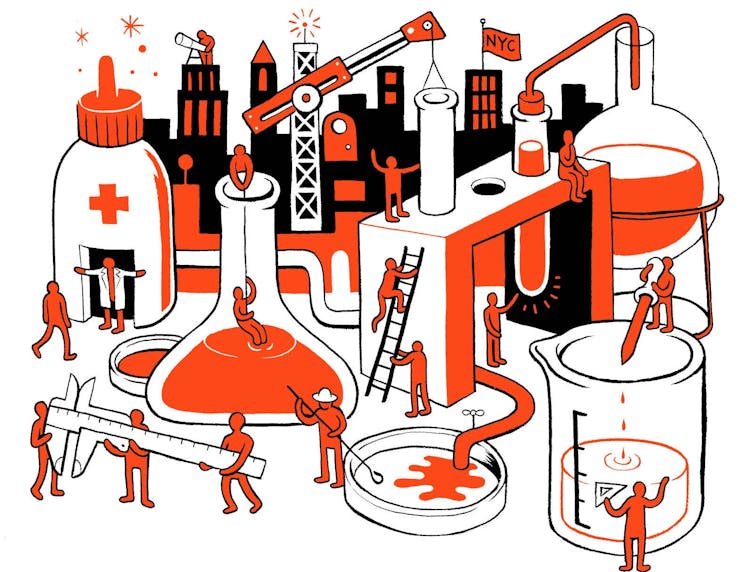
Education Images/Universal Images Group via Getty Images
Joshua Shanes, College of Charleston
As part of Harvard University’s agreement in response to two federal lawsuits filed by Jewish students alleging antisemitic discrimination, it will adopt the International Holocaust Remembrance Alliance, or IHRA, “working definition” of antisemitism.
This is a definition favored by many Jewish community leaders and politicians because its broad language can be applied to most anti-Israel rhetoric. This includes Kenneth Marcus, who served as assistant secretary of education during the first Trump administration and represented the students as chairman of the Louis D. Brandeis Center for Human Rights Under Law.
In contrast, many scholars prefer either the competing Jerusalem Declaration on Antisemitism or the definition offered by the Nexus Task Force, a committee of experts led by the Bard Center for the Study of Hate. I am a member of the Nexus group and also helped compose its 2024 “Campus Guide to Identifying Antisemitism.”
The controversy over this move indicates that many well-intentioned people still struggle to understand what exactly constitutes antisemitism and when anti-Israel rhetoric crosses the line.
As a scholar of modern Jewish history, I offer this primer that helps answer this question.
History of antisemitism
There has been a sharp increase in antisemitism around the world since the Oct. 7, 2023, massacre by Hamas and Israel’s subsequent military attacks in the Gaza Strip.
Anti-Jewish animosity dates to antiquity. The early Christian church attacked Jews, whom it blamed for crucifying Christ, and claimed to replace them as God’s chosen people. The Gospel of John in the New Testament accused Jews of being Satan’s children, while others called them demons intent on sacrificing the souls of men.
Medieval Christians added other myths, such as the blood libel – the lie that Jews ritually murdered Christian children for their blood. Other myths accused them of poisoning wells or desecrating the consecrated host of the Eucharist to reenact the murder of Christ; some even claimed that Jews had inhuman biology such as horns or that they suckled at the teats of pigs.
Such lies led to violent persecution of Jews over many centuries.
Modern antisemitism
In the 19th century, these myths were supplanted by the additional element of race – the claim that Jewishness was immutable and could not be changed via conversion. Though this idea first appeared in 15th-century Spain, it was deeply connected to the rise of modern nationalism.
Nineteenth-century ethno-nationalists rejected the idea of a political nation united in a social contract with each other. They began imagining the nation as a biological community linked by common descent in which Jews might be tolerated but could never truly belong.
Finally, in 1879, the German journalist Wilhelm Marr pushed the term “antisemitism” to reflect that his anti-Jewish ideology was based on race, not religion. Marr imagined the Jews as a foreign, “semitic” race, referring to the language group that includes Hebrew. The term has since persisted to mean specifically anti-Jewish hostility or prejudice.
The myth of a Jewish conspiracy
Modern antisemitism built on those premodern foundations, which never completely disappeared, but was fundamentally different. It emerged as part of the new politics of the democratic modern era.
Antisemitism became the core platform of new political parties, which used it to unite otherwise opposing groups, such as shopkeepers and farmers, anxious about the modernizing world. In other words, it was not merely prejudice; it was a worldview that explained the entire world to its believers by blaming all of its faults on this scapegoat.
Unlike earlier anti-Jewish hatred, this was less about religion and more about political and social issues. Antisemites believed the conspiracy theory that Jews all over the world controlled the levers of government, media and banking, and that defeating them would solve society’s problems.
Thus, one of the most important features of modern antisemitic mythology was the belief that Jews constituted a single, malevolent group, with one mind, organized for the purpose of conquering and destroying the world.
Negative traits attributed to Jews
Antisemitic books and cartoons often used claws or tentacles to symbolize the “international Jew,” a shadowy figure they blamed for leading a global conspiracy, strangling and destroying society. Others depicted him as a puppet master running the world.
In the late 19th century, Edmond Rothschild, head of the most famous Jewish banking family, was villainized as the symbol of international Jewish wealth and nefarious power. Today, the billionaire liberal philanthropist George Soros is often portrayed in similar ways.
This myth that Jews constitute an international creature plotting to harm the nation has inspired massacres of Jews since the 19th century, beginning with the Russian pogroms of 1881 and leading up to the Holocaust.
More recently, in 2018, Robert Bowers murdered 11 Jews at the Tree of Life synagogue in Pittsburgh because he was convinced that Jews, collectively under the guidance of Soros, were working to destroy America by facilitating the mass migration of nonwhite people into the country.
Modern antisemites ascribe many immutable negative traits to Jews, but two are particularly widespread. First, Jews are said to be ruthless misers who care more about their allegedly ill-gotten wealth than the interests of their countries. Second, Jews’ loyalty to their countries is considered suspect because they are said to constitute a foreign element.
Since Israel’s establishment in 1948, this hatred has focused on the accusation that Jews’ primary loyalty is to Israel, not the countries they live in.
Antisemitism and anti-Zionism
In recent years, the relationship between antisemitism and anti-Zionism has taken on renewed importance. Zionism has many factions but roughly refers to the modern political movement that argues Jews constitute a nation and have a right to self-determination in that land.
Some activists claim that anti-Zionism – ideological opposition to Zionism – is inherently antisemitic because they equate it with denying Jews the right to self-determination and therefore equality.
Others feel that there needs to be a clearer separation between anti-Zionism and antisemitism. They argue that equating anti-Zionism with antisemitism leads to silencing criticism of Israel’s structural mistreatment of Palestinians.
Zionism in practice has meant the achievement of a flourishing safe haven for Jews, but it has also led to dislocation or inequality for millions of Palestinians, including refugees, West Bank Palestinians who still live under military rule, and even Palestinian citizens of Israel who face legal and social discrimination. Anti-Zionism opposes this, and critics argue that it should not be labeled antisemitic unless it taps into those antisemitic myths or otherwise calls for violence or inequality for Jews.
This debate is evident in these competing definitions of antisemitism. Remarkably, the three main definitions tend to agree on the nature of antisemitism except regarding the relationship of anti-Israel rhetoric to antisemitism. The IHRA definition, which is by design vague and open to interpretation, allows for a wider swath of anti-Israel activism to be labeled antisemitic than the others.
The Jerusalem Declaration, in contrast, understands rhetoric to have “crossed the line” only when it engages in antisemitic mythology, blames diaspora Jews for the actions of the Israeli state, or calls for the oppression of Jews in Israel. IHRA defenders use that definition to label a call for binational democracy – meaning citizenship for West Bank Palestinians – to be antisemitic. Likewise, they label boycotts, even of West Bank settlements that most of the world considers illegal, to be antisemitic. The Jerusalem Declaration does not.
In other words, the key to identifying whether anti-Israel discourse has masked antisemitism is to see evidence of antisemitic mythology. For example, if Israel is described as leading an international conspiracy, or if it holds the key to solving global problems, all three definitions agree this is antisemitic.
Equally, if Jews or Jewish institutions are held responsible for Israeli actions or are expected to take a stand one way or another regarding them, again all three definitions agree that this crosses the line because it is based on the myth of a global Jewish conspiracy.
Identity and pride
Critically, for many Jews living in other countries, Zionism is not primarily a political argument about the state of Israel. It instead constitutes a sense of Jewish identity and pride, even a religious identity. In contrast, many protests against Israel and Zionism are focused not on ideology but on the Israeli government and its real or alleged actions.
This disconnect can lead to confusion if protests conflate Jews with Israel just because they are Zionist, which is antisemitic. On the other hand, Jews sometimes take protests against Israel in defense of Palestinian rights to be attacks on their Zionist identity and thus antisemitic, when they are not. There are certainly gray areas, but in general, calls for Palestinian equality, I believe, are legitimate even when they upset people with Zionist identities.
Harvard’s statement captures this distinction. It posted a statement that, “For many Jewish people, Zionism is a part of their Jewish identity,” and added that Jews who subscribe to this identity must not be excluded from campus events on that basis.
This does not mean that Jews are protected from hearing contrary views, any more than they are protected from hearing Christian preachers on campus or professors who teach secular views of the Bible. It means that they cannot be excluded based only on those beliefs.
This does not, however, require an adoption of the IHRA definition of antisemitism, which goes much further. Many advocates of the IHRA definition use it to label political calls for Palestinian equality as antisemitic, as well as accusations against Israel that they consider wrong or unfair.
Harvard’s adoption of the IHRA definition, accordingly, would mean that any speech that calls for full equality for Palestinians risks academic and legal sanction, even without any material discrimination against Jewish students. It is thus opposed by students who advocate for Palestinian rights as well as supporters of free speech more generally.
Editor’s note: This is an updated version of an article first published on Jan. 29, 2024
Joshua Shanes, Professor of Jewish Studies, College of Charleston
This article is republished from The Conversation under a Creative Commons license. Read the original article.





















































